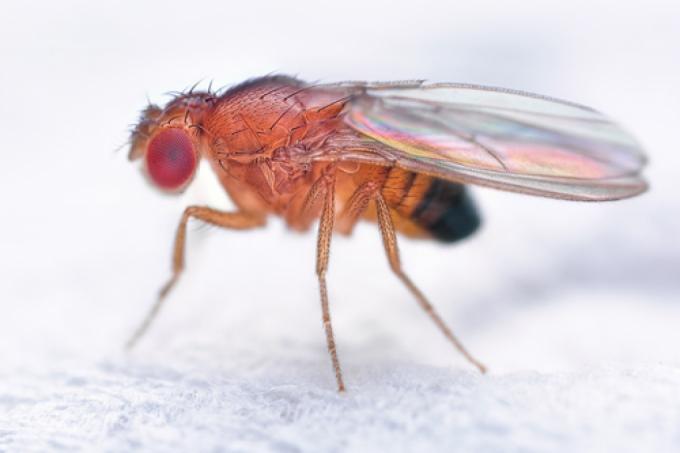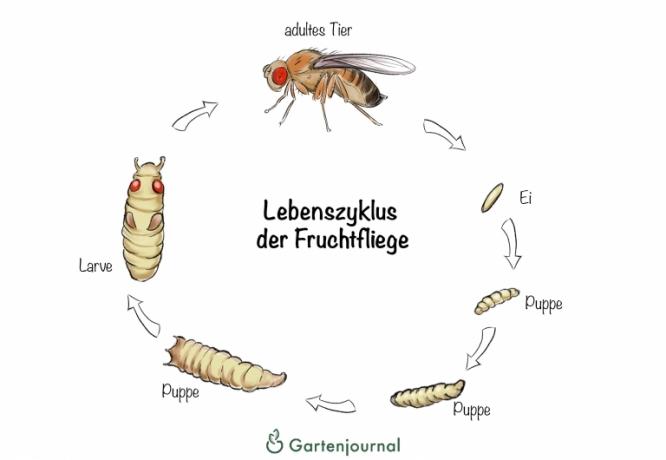the essentials in brief
- Vinegar flies can be used with various self-made trap z. B. be caught with wine, fruit juice, or vinegar and dish soap
- Carnivorous plants are not a good control measure as they only eat a fly every few days.
- As a preventive measure, compost bins should be tightly closed and no bad or cut fruit should be left lying around.
What can be done against vinegar flies?
The first aid against fruit flies is to reach for the vacuum cleaner. As you slowly approach the insects sitting on the wall, you can simply vacuum them up. This will allow you to get rid of most of the insects quickly. To get rid of the flies that have escaped, you should use various means.
also read
- Carboniferous hernia - Recognize, fight and successfully prevent the fungal disease
- Fight insects successfully, but biologically
- June beetles - detect, prevent and fight
Build a trap
Take a bowl or glass and fill it with a liquid or fermenting fruit such as grapes. Pull cling film over the opening. Pierce several holes in the foil with a nail. These serve as entry openings. The insects find their way inside without any problems, as the aromas only flow out of the openings. This way you can easily catch and eliminate the annoying flies, because they can no longer escape from the trap.
Youtube
| effect | advantage | |
|---|---|---|
| Denture cleaner | drives away vinegar flies | more pleasant than vinegar smell |
| Erythritol | attracting, paralyzing, killing | not harmful to health |
| Tomato leaves | chilling aroma | no odor nuisance |
Fly trap with wine
Fill a shot glass with white wine and add a few drops of dish soap to reduce surface tension. A little apple cider vinegar provides an even stronger attraction. Place the jar near the fruit baskets. The liquid gives off a more intense smell than the fruit, so that the insects fly to the shot glass. If you try to settle, the insects will drown.
Variations:
- fruit juice
- beer
- sparkling wine
Yeast milk
Melt a quarter of a fresh yeast cube in lukewarm water and stir in a teaspoon of sugar. When the milky liquid is in a warm place, fermentation begins. Fill a bottle with the milk and place it in the kitchen.
The fruit flies are magically attracted by the scent and fly into the narrow neck of the bottle, from which they cannot find their way out again. When the bubbles stop forming and fermentation stops, you can always feed the yeast with some sugar. If too many vinegar flies have collected in the liquid, replace them completely.
Carnivorous Plants

Carnivorous plants "eat" vinegar flies, but they cannot destroy a plague
Venus Flytrap, Butterwort and sundew are ideal plants for the bright windowsill in the kitchen and living room. The carnivores do not grow too big and are relatively easy to care for if the water balance is right. Since the plants have a limited absorption capacity, they cannot kill large amounts of vinegar flies.
It usually takes several days for an insect to be digested and for the plant to be able to invest energy again in the production of digestive secretions. Therefore, carnivorous plants are suitable as a preventive measure against the spread of fruit flies. You can contain the population right from the start and prevent the insects from multiplying uncontrollably.
Large-leaved and strong-growing species:
- Drosera: D. capensis, D. spatulata, D. aliciae
- Pinguicula: 'Sethos', 'Tina', 'Weser'
- Dionaea: 'Crocodile', 'Akai Ryu', 'Bimbo'
Digression
Natural trap - this is how carnivores catch their prey
Once the carnivores have caught their prey, a secretion ensures digestion. The fruit flies will decompose over the next few days, leaving the indigestible chitin shell behind. These remains dissolve over time.
Drive off the cake
Vinegar flies are also attracted to fruits on cakes and other baked goods. Since a trap near food is not only repulsive but also appears unhygienic, you can use another trick.
That scares off vinegar flies:
- Halve the lemon
- Crumble the cloves into the pulp
- Spread lemon halves between cake plates
- Use fresh lemon every two to three days
Recognize vinegar flies

Drosophila melanogaster, the most common fruit fly in our country, has red eyes
Fruit flies represent a family also known as the fruit flies. A common species that prefers to be close to humans is Drosophila melanogaster. This insect is about three millimeters in size and can be recognized by its yellow-brown carapace and red compound eyes. The species, which originally came from the tropics, has spread worldwide through humans and overwintered in houses.
| Black-bellied fruit fly | Cherry vinegar fly | |
|---|---|---|
| scientific | Drosophila melanogaster | Drosophila suzukii |
| size | approx. 2.5 mm | approx. 2 to 3.5 mm |
| Specialty | Males with dark colored abdomen | Males with dark spots on wing tips |
Tips
Vinegar flies prefer citrus fruits for their eggs. Therefore, you should dip exposed lemons and oranges in a vinegar bath.
Sciarid gnats and fruit flies
Behind the sciarid gnats hides a family that is only remotely related to the Fruit flies Is related. It belongs to the subordination of mosquitoes, while vinegar flies are classified in the subordination of flies. The larvae of these small black flies develop in the Potting soil. The females lay their eggs on bare substrate so that the larvae can burrow into the protected soil. They feed on plant roots. Sciarid gnats like a humid and warm microclimate.
The small black flies that come out of the potting soil should not be confused with vinegar flies.
Drill flies and fruit flies

Drill flies have yellowish-green eyes
Drill flies are a family closely related to fruit flies, for which the German trivial name fruit flies has also become established. These flies have strikingly drawn wings and lay their eggs in parts of plants and fruit with a boring stinger. Some species cause considerable damage in fruit growing. However, they are out of the question as pests in private households.
Where do vinegar flies come from?
Fruit flies buzz around the compost heap in the warm summer months or look for overripe fruit in the garden. They are attracted to sweet smells and enter the apartment through open windows. But you often bring vinegar flies home with your grocery bag.
This is where fruit flies occur:
- on overripe and damaged fruit
- in supermarkets with food stored in the open
- on the compost
Life cycle and development
The females can lay up to 400 eggs, which they attach to ripe to putrid parts of the plant. The later hatching larvae are supplied with food in this way. They feed on dead plant debris, rotten fruit and microorganisms such as yeast and bacteria that decompose the fruit.
During their development they go through three larval stages before they pupate. Depending on the environmental conditions, the development takes ten to 14 days, so that fruit flies can develop several generations per year. This way, they quickly become a nuisance in the kitchen.

How can I prevent an infestation?
Since vinegar flies feel comfortable in a warm and windless environment, you should ventilate rooms thoroughly and regularly. Leftovers that settle in niches behind the oven or next to the refrigerator serve as a food source for fruit flies. Therefore, you should clean such corners well. Wash all fruit thoroughly, even if it is not damaged or contaminated.
Here are some things to look out for:
- Avoid contaminated fruit and vegetables when buying
- Store fruit and vegetables in the refrigerator in the warm summer
- Wipe off sticky residues from leaked beverage packages
- Organic waste Store in closed containers and dispose of regularly
Tips
The eggs need moisture in order for larvae to hatch. Therefore, do not leave any food open.
frequently asked Questions
What can you do about vinegar flies?
As the name suggests, vinegar flies are attracted to vinegar. Set up a container which you fill with a mixture of vinegar, washing-up liquid and wine or fruit juices. Cover the trap with cling film and poke a few holes in it. The fruit flies will find their way to the liquid, but will no longer come out of the jar.
These smells are off-putting:
- dried olive herb
- fresh tomato leaves
- crumbled cloves
Where do fruit flies live?
The females lay their eggs on putrid parts of plants and fermenting fruit so that the larvae that later hatch can find enough food. Unlike fungus gnats, they do not live in the potting soil. The insects prefer a warm and windless environment. They need moisture to lay their eggs. Leftovers from leaked beverage cartons are sufficient as a livelihood. The insects spend the winter as a pupa in leftover food or in compost.
How can I spot vinegar flies?
The insects are two to three millimeters in size. Usually the females are slightly larger than males. They can be recognized by their typically red colored compound eyes. Their body shimmers yellowish-brown to reddish, with males of some species having a dark-colored abdomen. Other fruit flies have a dark spot on the wing tip. The eggs are not bare eye to recognize.
Do trade fly traps help against fruit flies?
Many products are efficient means of combating a fruit fly infestation. They use liquids that act as attractants. With the help of a funnel, the flies are caught in a vessel. However, you can build such traps yourself with simple means and save money. An empty wine bottle with small remnants is enough to catch fruit flies.

